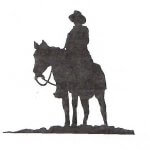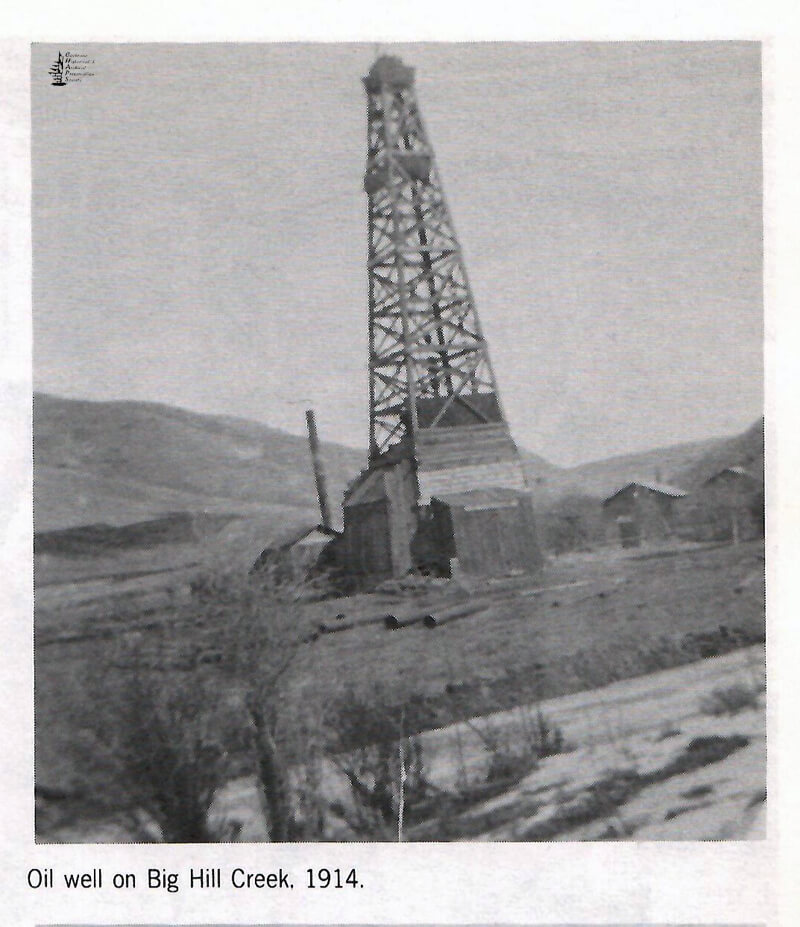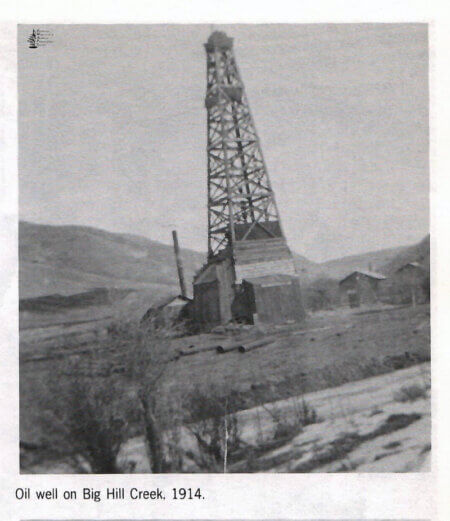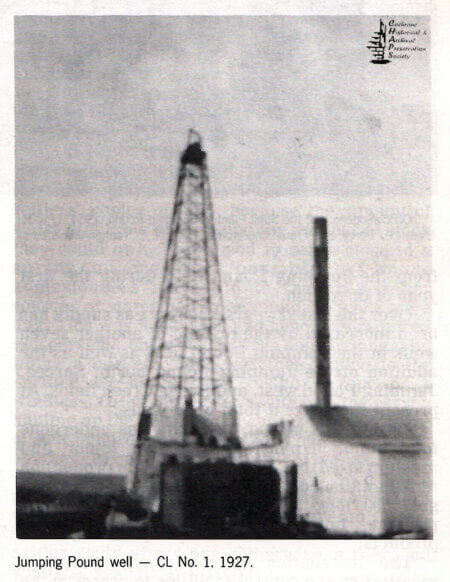Page 65 Big Hill Country 1977
In 1914 there were ten oil companies drilling in the Jumping Pound area. Natural gas had been leaking out of fissures in the ground in the district since the earliest times but had attracted little attention until 1914. Some idea of the availability of gas pockets may be gained when the experience of the Purity Gas Co. in 1914 is considered. This company drilled to a depth of 890 feet and discovered three large gas deposits in that distance. Throughout 1914, 1915 and 1916 various companies drilled wells. Some of them went to a depth of 3000 feet, but, although great quantities of gas were discovered, there was little crude oil. In 1927 Imperial Oil drilled a well 5200 feet and still did not find oil.
Since the Second World War, Shell Oil Co. has drilled two wells to a depth of ten thousand feet but has been unable to find oil in commercial quantities. This company turned its attention to the natural gas in the district and constructed a large scrubbing plant to purify the gas for export. The gas contains large amounts of sulphur compounds, and methods were developed to purify the gas and make the development of this natural resource profitable. A pipeline to Calgary was completed in 1950, and work then began on a line to Exshaw and Banff.
The Shell Plant is located 11 miles southwest of Cochrane on the west bank of the Jumping Pound Creek. The original plant was officially opened on May 7, 1951, with a treating capacity of 20 million cubic feet per day of sweet natural gas. It employed 15 men. A Sulphur Recovery Plant was added and went into production on February 2, 1952, with a capacity of 27 long tons of sulphur per day. The Sulphur Recovery Plant has the distinction of being the first of its kind in Canada. Four wells supplied the feedstock to the plant from the Jumping Pound field during the first year of operation.
Over the last 22 years, the raw gas supply has been increased by the drilling of another seven wells in the Jumping Pound field as well as the addition of the Jumping Pound north, Sarcee, Jumping Pound west, and Bragg Creek fields. At present, there are a total of 29 wells.
During this period, the plant has undergone four major expansions and five minor and medium-sized expansions, increasing production to 200 million cubic feet per day of sweet natural gas, 500 long tons of sulphur per day, plus propane, butane, and pentane as additional products.
The installation of continuous operating, monitoring, and control facilities to preserve the environment has been a significant factor included in the various expansions.
The Jumping Pound plant supplies more than 70% of the domestic and industrial requirements of the city of Calgary and 100% of the requirements of Cochrane, Morley, Exshaw, Canmore, and Banff.
The plant employs 69 Shell personnel as well as a contract maintenance group averaging 23 personnel. All personnel commute daily from Cochrane and Calgary.
The Wildcat Hills gas field, situated about 10 miles west of Cochrane, was discovered in December 1958. The field initially contained seven producing wells and development drilling has continued over the past fifteen years to the point where eighteen wells now produce gas for the plant.
The Wildcat Hills gas processing and sulphur recovery plant is located nine miles west of Cochrane, on the north bank of the Bow River. It is operated by Petrofina Canada Ltd. for a group of five owner companies, including Petrofina. The plant was started on January 1, 1962, and processes a sour gas stream from the Wildcat Hills gas field to the northwest of the plant. The sales products from this plant are sweet natural gas, liquid hydrocarbons, and sulphur.
With over ten years of production from the field, the natural pressure in the underground reservoir has dropped considerably. In order to maintain a high rate of production, it has become necessary to lower the field pipeline pressure. Since the plant has to operate with an inlet pressure of 1,000 pounds per square inch, the pipeline had to be boosted ahead of the plant. For this reason, in 1972, two 1,670 horsepower compressors were installed, being the first major addition to the plant.
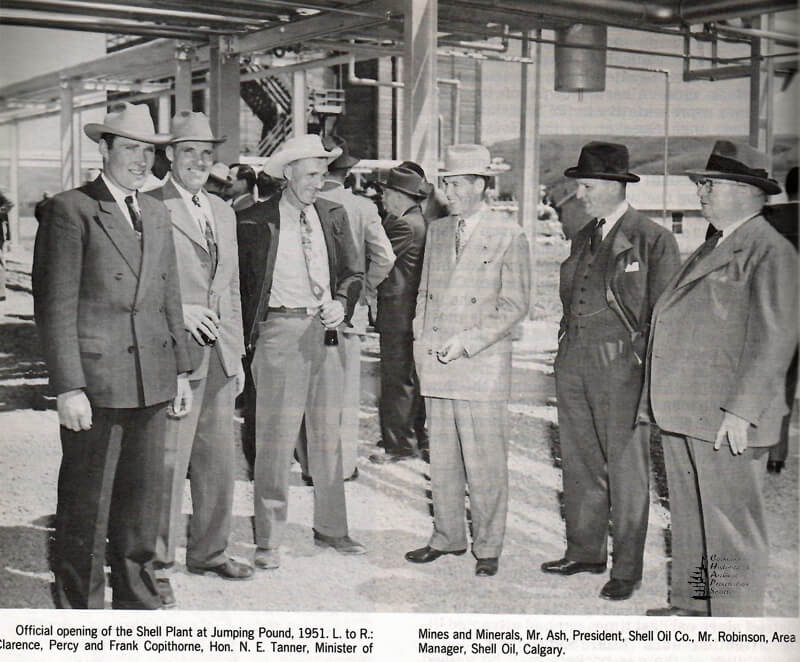
While the plant requires only three people a shift to run it, the total number of persons working in the plant and field is 38; of these, 16 live in Cochrane and the district, and the remainder in Calgary.
A third plant, the Alberta Natural Gas Company Cochrane Extraction Plant is located one and a half miles northwest of Cochrane. It is the second largest of its kind in the world. The plant is designed to process 830,000,000 standard cubic feet of pipeline gas per day. This is enough to heat eight cities the size of Calgary for one day. From the pipeline gas, propane and other liquid hydrocarbons are extracted. All plant liquid hydrocarbon production has been contracted for a forty-year period.
Installation of new equipment to the value of approximately 60 million dollars is expected to begin in 1977. This equipment is necessary to accomplish the recovery of ethane in addition to the present production of butane and propane.
During the construction of this plant in 1969, 400 men were employed. This highly automated plant went on stream in 1970, and presently employs 23 people on site, many of whom are Cochrane and district residents.
In 1962 the first producing oil well near Cochrane was drilled in the Lochend area. There are presently eight oil wells in production in the Lochend-Inglis field. It is classed as a “stable field;” the oil is recovered from a seven-foot pay zone in the Cardium formation.
An excerpt from a book entitled “Oil Finding,” by E. H. Cunningham Craig, printed in London in 1914, is interesting in regard to the discovery of oil and gas. E. H. Cunningham Craig was the man J. A. W. Fraser had as a guest at Jumping Pound when the oil boom was on in Calgary. It was on this man’s advice that Mr. Fraser formed the company Petrol Limited, with headquarters in Belgium. Plans fell by the wayside with the invasion of Belgium in 1914. Mr. Cunningham Craig writes.
“It is, of course, in the case of the first test well of a new field, or presumed field, that the importance of carefully selecting a site is more forcibly brought home to us, and it is this aspect also which appeals most to the general public. The geologist who undertakes oilfield work will soon weary of the oft-reiterated question, “How do you know where to put a well?”
“There are many methods of actually making the first selection. It is told of one well-known and very successful exploiter and driller in the United States he frankly stated that his method was to put on an old and cherished hat and gallop a rough horse about the countryside or farm till the hat dropped off. On the spot where it fell, he drilled the well. The story is at least “ben travato,” and it is possibly quite true.
“The writer knows one highly productive and very valuable field, miles from the nearest surface indication, where the first test-well site was selected in almost as haphazard a fashion. Drillers and field superintendents had met to make the location, and the area in which a spot was to be selected was generally determined, but with characteristic caution none would venture an opinion before the others as to what exact spot should be fixed upon. At last, one bolder spirit than the others, spoke up and said, ‘Well, boys, if it’s all the same to you, let’s put the well where that crow sits down,’ pointing at the same time to a crow which was flying about them. The crow alighted, the spot was marked, and the well drilled with remarkably successful results; it is still producing after eleven years. A flight of a hundred yards or so further to the eastward would have put the well beyond any hope of striking oil.”
In 1914 and part of the year 1915 a well was drilled on Sec. 11-26-4-5. It was drilled by the National Oil and Gas Company and called Cochrane No. 1. They went to a depth of 1400 feet using standard cable tools. There are no records showing it produced gas or oil and the site was abandoned in 1915.
